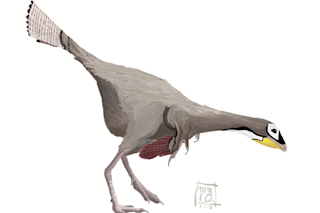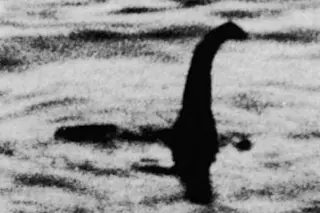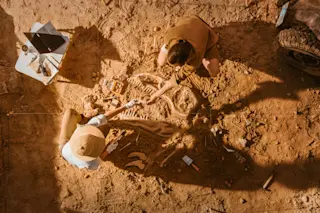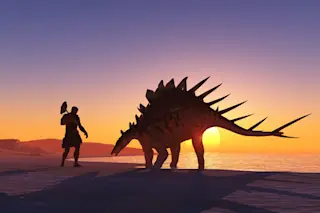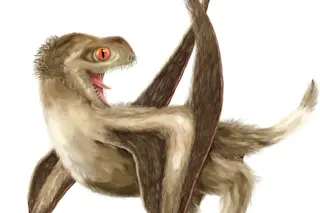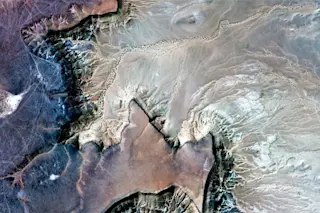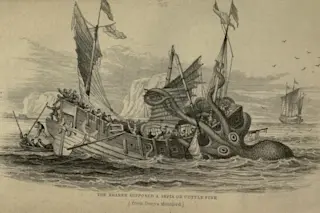Rich McCrea crouches and springs into a flying leap, hovering above the raging waters of Quality Creek for a split second before landing on the opposite bank. "This is it," he says, peering underneath a sandstone ledge that juts from the weathered rock face. Hidden in shadow on the shelf's underside is a well-preserved set of three-toed tracks left by ornithopods, duck-billed dinosaurs from the Cretaceous Period. Unlike the shallow tracks that beachcombers leave in sand, the fossilized ornithopod prints are domes that project from the rock in upside-down relief. McCrea pokes his head out and grins. "If I were standing in this exact spot 93 million years ago, I'd be beneath the earth's surface, and I'd be able to hear dinosaurs walking overhead," he says.
McCrea, a paleontologist at the Peace Region Palaeontology Research Centre in Tumbler Ridge, British Columbia, is as quick and nimble as Indiana Jones, but he identifies more closely with Sherlock Holmes. Like Holmes, he is a dogged detective with an uncanny instinct for spotting minute clues. By scrutinizing footprint fossils in rock—subtle swells and indentations that are easy for the untrained eye to miss—he is assembling a more complete picture of how dinosaurs behaved, traveled, and interacted than even their bones can provide. "When it comes down to it, the best-preserved skeleton is still a corpse," McCrea says. "Footprints were left behind when the dinosaur was still alive, so they're like very brief snapshots of an animal's history."
Track sleuthing, or ichnology, is a branch of paleontology that's just coming into its own, with some of the most dramatic and surprising discoveries occurring in the wilds of western Canada. The area emerged as a fertile ichnological hunting ground in 2000 when two boys rafting in Tumbler Ridge landed on a creek bank embedded with fossil tracks after their inflatable tube boat capsized. McCrea has since traveled far and wide in British Columbia and Alberta, looking for places where white-water creeks slice channels into bedrock, miners drill through cliff faces, and inner-earth processes push hills into craggy mountains. All the geologic action helps reveal rock strata from the Triassic, Jurassic, and Cretaceous periods, when dinosaurs roamed the earth. "I don't dig for tracks," McCrea says. "I let the landscape do the work for me." His finds, made without picks or shovels, include some of the most complete sequences of ankylosaur and duck-billed dinosaur tracks anywhere in the world—and a rare tyrannosaur print for good measure.
McCrea is always on the lookout for wide slabs of exposed ancient bedrock, which often contain prints dinosaurs made as they walked across sandy shorelines. Such prints are preserved in a sandstone matrix when grains of sand fuse over the course of millions of years beneath the weight of accumulating layers of sediment. But tracks can also show up in less obvious places. If a dinosaur stepped through mud instead of sand, the prints themselves wouldn't survive as fossils; because of its high organic content, mud turns into crumbly coal when compressed beneath other sediment layers. On occasion, though, new sediment with a higher mineral content than the mud fills the track imprints like wet plaster filling a mold. When this natural plaster hardens into sandstone, the result is a set of "infill prints," inside-out track marks that are often found beneath rock ledges like the one at Quality Creek. By comparing the outlines of footprint fossils with the shapes and dimensions of dinosaur foot bones, ichnologists can determine what type of animal made them.
Close examination of the tracks sometimes also offers clues about the daily routines and social habits of dinosaurs. During a trip to a mining area near Grand Cache, Alberta, McCrea studied a mix of prints from four-legged ankylosaurs, birds, and meat-eating dinosaurs called theropods. He was stopped short by a mile-wide swath of bedrock containing ankylosaur prints that were closely spaced, indicating that the armored plant-eating dinosaurs once congregated there in large numbers.
Curious to find out why, McCrea did an analysis of the site's mineral composition. The results revealed that rocks in the area where the ankylosaurs congregated were more fine grained in texture and contained a higher degree of coal than those found elsewhere, suggesting the area was once a stagnant locale containing lots of organic material. A swamp, McCrea thought, feeling like Archimedes in the bathtub. Of course! He already knew ankylosaurs' teeth were exceptionally flat and dull, so it made sense that they would gravitate toward soft, mushy swamp plants—the dinosaur equivalent of baby food. Their four-toed feet, as wide as snowshoes, would also have been ideal for navigating sludgy swamp bottoms. By contrast, the bipedal meat eaters would not have fared nearly as well in the mud with their bird-talon-like feet and long legs, and hence probably steered clear of the swamp.
Tracks also provide a window into dinosaurs' social lives, revealing whether a particular type of animal was a loner or traveled in packs. A few sets of tracks made side by side, however, don't necessarily indicate the presence of a herd. If one or more of the track sets appears less crisply outlined than the others, that means the soil conditions under which the tracks were made varied—and therefore that a significant time interval passed between the animals' journeys.
Similarly, if McCrea comes across several dinosaur trackways that periodically cross one another, he's highly skeptical that the animals were traveling together. "The best indication that you've really got a herd is when one set of tracks veers off and the other, parallel track lines swerve in the same direction as well," McCrea says. "That shows you the animals were trying to keep a consistent amount of space between them." Evidence of dinosaur herding behavior has turned up at several sites in Alberta and British Columbia. Other herd traces can be found in the Purgatoire River valley in Colorado, where trackways made by herbivorous sauropod dinosaurs are overlaid by delicate three-toed prints made by packs of meat eaters that were trailing the herd.
McCrea is looking to add even more detail to the broad portrait he has assembled of dinosaurs' eating and socializing habits. It is sometimes easy to tell a meat-eating dinosaur's track from a plant eater's because a meat-eater's feet have long, claw-tipped toes, but making this distinction can be a problem when only part of the foot, such as the heel, has been preserved in an imprint. McCrea's research suggests that the skin ridge patterns found in some footprint fossils are unique to particular groups of animals. If his investigation of hundreds of prints supports this theory, researchers will be able to look at fossilized partial imprints only a couple of inches square and determine with a high degree of certainty what type of dinosaur made them.
While McCrea's work focuses on what footprint fossils reveal about behavior, researchers like Julia Day at the University of Cambridge in England have used print data to flesh out the big picture of dinosaur biomechanics. After taking measurements of foot size and stride length from meat-eating dinosaur footprint sequences in Oxfordshire, Day used these numbers to calculate how fast the animals were moving when they made the prints. Large theropods like Tyrannosaurus rex and Megalosaurus, she concluded, usually ambled around at about 4 miles per hour but could rev up to 19 mph in pursuit of prey. While impressive for a 13,000-pound animal (the fastest humans top out at about 23 miles per hour), these figures put the kibosh on popular mythology—especially the classic Jurassic Park chase scene in which a T. rex cruises at 50 miles per hour to keep pace with an SUV.
McCrea wants to follow Day's lead and probe the prints he has found for clues about dinosaurs' biological capabilities, but he doesn't have as much time for inference as he would like. Since a detective's first order of business is to gather all available evidence, his highest priority is to map and describe every track site he has found before erosion and industrial development get the best of them. "You have to start by collecting the raw material, and that's what I'm doing now," he says. This summary work alone, he estimates, could take at least a couple of decades. Still, he is convinced the eventual payoff—providing a new set of clues for deciphering the mysteries of dinosaur life—will make it all worthwhile.




